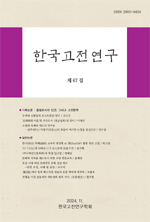『해동염사』에서 전통과 근대의 조우
The Encounter of Tradition and Modernity in Haedongyeomsa
- 한국고전연구학회
- 한국고전연구(韓國古典硏究)
- 제68권
-
2025.02123 - 159 (37 pages)
-
DOI : 10.20516/classic.2025.68.123
- 10

이 글은 차상찬(車相瓚, 1887∼1946)의 『해동염사(海東艶史)』에서 전통과 근대가 어떤 방식으로 조우하는가를 기술하고자 한다. 이를 위해 차상찬이 참조한 것으로 보이는 전대 문헌 및 당대 문헌들을 살펴보고, 전근대적 자료들의 집적과 근대적 글쓰기가 만나 형성하는 새로운 담론의 논리를 탐색한다. 먼저 『해동염사』는 전근대 여성 서사를 종합적으로 수용하면서, 이를 ‘역사’로 자리매김하려 했다. 『해동염사』의 기저가 되는 원고를 쓸 때 차상찬은 당대의 문헌(특히 『조선해어화사 』와 『조선여속고 』), 전대의 문헌(야담류)뿐 아니라 구술 전승과 답사까지 최대한 활용한다. 그러면서도 『해동염사』는 세부적 문장에 있어서는 근대적 글쓰기의 면모를 보이는데, 여성의 능력과 미추에 대한 강조된 서술, 사랑에 빠진 남성과 여성의 빈번한 등장, 그리움과 반가움 등의 정서에 대한 확장이 그것이다. 그 결과 『해동염사』는 남녀와 부부의 관계를 윤리가 아니라 감정적, 정서적인 것으로 바꾸어 놓는다. 결국 전통적 기록주의적 태도에 입각하여 여성들의 삶을 망라하고자 한 『해동염사』는 시대, 신분, 능력, 자질, 미추 등에 있어 인물의 다양성을 담보하면서도 이들을 역사적으로 실재한 인물처럼 구성해 낸다. 그러나 사랑과 정서의 낭만적 언어로 수식되는 그들의 내면과 행위는 다양하기보다는, 근대인의 연장선 위에 있는 것처럼 재현된다. 『해동염사』는 전통적 기록주의와 근대의 낭만적 수사가 만나 생성된 새로운 여성 역사이다.
This study aims to describe how tradition and modernity intersect in Haedongyeomsa. By examining the text of Haedongyeomsa and the preceding and contemporary documents it appears to reference, this research explores how premodern narratives and Chasangchan's modern writing converge to reconstruct the lives of women in the past. Firstly, Haedongyeomsa comprehensively embraces premodern women's narratives, effectively compiling and positioning them as “history.” While composing the manuscript that forms the basis of Haedongyeomsa, Chasangchan extensively utilized contemporary texts (notably Joseon Hae-eohwasa and Joseon Yosokgo), earlier texts (such as collections of unofficial historical tales), as well as oral traditions and field investigations. Despite this, the detailed sentences of Haedongyeomsa reveal characteristics of modern writing—emphasizing women's capabilities and appearances, frequently depicting men and women in love, and expanding on emotions like longing and joy. Consequently, Haedongyeomsa transforms the relationship between men and women, and between spouses, from one grounded in ethics to one rooted in emotions and sentiments. Ultimately, Haedongyeomsa, which sought to encompass the lives of women through a traditional archival approach, secures the diversity of its characters in terms of era, social status, abilities, qualities, and appearances. Yet, their inner lives and actions, described through romantic and emotional language, are portrayed less diversely and more as extensions of modern individuals. Haedongyeomsa represents a new history of women created through the intersection of traditional archivalism and modern romantic rhetoric.
1. 서론
2. 전통 여성 서사의 종합적 수용 및 배치
3. 외모의 묘사와 정감의 강화
4. 결론: 기록주의와 낭만주의의 결합으로서 여성 역사
(0)
(0)